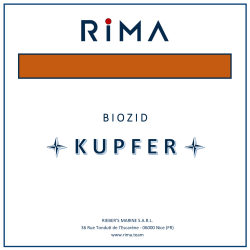Home
Subcategories
-
Epoxy resin
RIMA Epoxy Resin is characterised by excellent material properties:
Durable (>50 years)
Extreme mechanical strength (compare with steel)
Acid and corrosion resistant
Dimensionally stable, impact and abrasion resistant
High adhesion / adaptable processing method
Environmentally friendly, without toxic biocides
Sea water resistant, protects against fouling
...
After curing, the synthetic resin is extremely stable respectively long-lasting - thus only a one-time application is required. This way, you permanently protect your underwater hull as well as the environment.
-
Additives
Additives are added to the liquid epoxy resin mixture to produce special product properties for processing: for example, better sandability, trowelability or - especially for the underwater hull - a natural biocide (copper).
Cotton - has a thickening effect and increases impact and tensile strength.
Talc - serves as a filler and improves subsequent sandability.
Glass - serves as a filler and increases the elastic stability of repair areas.
Thixo - has a thickening effect and increases the adhesive strength, also acs as a binding agent.
Copper - has a natural oxydating effect against antifouling (biocidal effect)....
Depending on the requirements, different mixing ratios are used (table). Please observe the technical data sheet as well as the safety instructions ('Appendices').
...
-
Equipment
When using epoxy resin, various tools and consumables are required:
Precision scale
Mixing cups
Nitrile gloves
Wooden spatula
Protection mask/goggles
Plastic spatula/rollers...
Please always use protective mask/glasses, nitrile gloves and work clothes when working with RIMA epoxy resin/hardener as well as the additives.
...
-
Method
PREPARATION
Provide all working materials and use the protective clothing (safety instructions). The environment should be between 10 and 25 degrees Celsius and not too humid. Avoid any exposure of the resin to sunlight or heat, as this may lead to premature curing/boiling.Put the precision scale into operation (batteries) and cover it with a thin transparent film for protection.
...
...
1. MIXING
Place an empty mixing cup on the precision scale and press the "Tare" button - the scale should now show zero grams.
...
1. Fill 100g of RIMA Epoxy Resin into the mixing cup - the scale will now show approx. 100g.
2. Add 30g of RIMA Epoxy Hardener into the mixing cup - the scale will now show approx. 130g.
3. Stir the contents of the mixing cup with one of the spatula for about 1-2 minutes. Then wait another 1-2 minutes (polymerisation).
...
You now have approx. 130g of finished, liquid epoxy resin.
...
...
2. ADDITIVES
Depending on the intended use, add the additives to the epoxy resin in the same way: After adding an additive, stir briefly and wait 1-2 minutes so the substances can combine. Please refer to the table provided with your order to obtain the desired result.
...
The amount of resin respectively additives may be changed - but always in the same ratio (e.g. 200g resin and 60g hardener). Please note that the quantity of additives must then also be adjusted accordingly.
...
...
3. PROCESSING
Now use the finished epoxy resin mixture and apply it to the previously-cleaned surface.
...
You can do this with a spatula, an epoxy-capable roller or even a dosing syringe (e.g. injection into a cavity). If necessary, incorporate glass fibre mats into your work. Complete your work in such a form as it should be given later.
...
Now let the epoxy resin harden and remove any dirt. After 24 hours at the latest, the resin will have hardened.
...
...
UNDERWATER HULL
For your underwater hull, we recommend removing the old antifouling coats; at least the loose components. If sandblasting is not available, we recommend using a coarse-grained, domed metal abrasive disc ('claw' disc) for this. However, avoid using it with a speed too high.
...
Ideally, after removing and cleaning the underwater hull with a high-pressure cleaner, leave it for some time so that any moisture that escapes due to osmosis can dry completely. Depending on the condition of your underwater hull, this process can take several weeks (e.g. winter).
...
It is then advisable to apply several layers of RIMA epoxy resin:
...
...
1. Pure epoxy resin (without additives) as primer/first coat (roller)
...
2. Filling with talc-resin to remove unevenness.
...
3. Then sand the underwater hull smooth with ordinary sanding discs.
...
4. Repairs are made with fibreglass or copper-resin (e.g. shaft suspension, fractures in the keel, etc.).
...
5. Finally, the entire underwater hull is filled or painted 1-2 times with RIMA epoxy copper-resin.
...
...
Your underwater hull now has permanent, professional underwater protection!!
...





